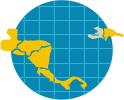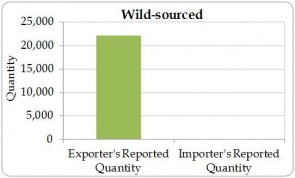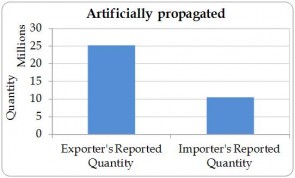The focus of this chapter is on inconsistencies in reporting between the seven countries in the Region and their trading partners. Potential explanations for inconsistencies in reporting are discussed and particularly notable inconsistencies are highlighted.
CITES trade data are a valuable resource for informing the regulation and management of trade in CITES-listed species[1]. Analysis of the data can reveal potential unsustainable or illegal trade and can also indicate when trade has shifted from one commodity to another. For CITES Authorities, analysis of national data can help to place trade in an international context. It can also help Authorities to plan research, target enforcement training and identify other countries that may face similar issues with implementation of the Convention.
To benefit fully from these aspects of trade data analysis, accurate reporting of trade is vital. Inconsistencies in reporting, whilst highlighting differences in implementation of the Convention by different Parties, can make it difficult to draw meaningful conclusions from the data with the appropriate level of certainty.
Inconsistencies in reporting have been noted in many reports during the lifetime of the Convention[2]. Such inconsistencies include, for example, discrepancies in quantities reported in trade (often arising when one Party reports on permits issued instead of actual trade), differences in the taxonomic entity that is reported (e.g. if reported at a higher level or if improperly identified), differences in use of purpose and source codes and differences in the term (e.g. skin pieces and skins) and units of measure reported (e.g. kg or number of items). The Guidelines for the preparation and submission of CITES annual reports (CITES Notification No. 2011/019) provides guidance on the correct term to use to describe the item in trade, as well as the preferred and alternative units of measure that correspond to each term.
This chapter examines inconsistencies in reporting from the Region using the methodology outlined below; permit numbers were cross-referenced to provide potential explanations for these inconsistencies.
Methodology
To identify discrepancies of note based on quantities recorded in trade, all direct exports from the Region 2003-2012 (as recorded exported by the Region and as imports by trading partners) were extracted as a comparative tabulation from the CITES Trade Database. In order to enable better matching of shipments between trading partners, purpose codes were not taken into account in the comparative tabulation (purpose codes are often reported using different, but equally valid, codes). Differences were identified over the ten-year period 2003-2012 as a whole, rather than examining individual years, to minimise discrepancies resulting from ‘year-end’ trade.
The trade data was split into two categories – 1) trade that was recorded by both trading partners, but where a notable discrepancy existed and 2) trade that was recorded at notable levels but reported by only one trading partner. Of the trade recorded by both trading partners, cases were categorised as “notable” if a) the highest of the two values (exporter- and importer-reported quantities) was more than five times the corresponding quantity recorded by the other trading partner and b) if the higher value of the pair was greater than 1000 units (all terms/unit combinations considered). For those cases only recorded by one trading partner, the top ten of note (based on the quantities reported in trade), by source, are highlighted as potential discrepancies.
This chapter focuses on trade reported at the species or subspecies level (including hybrids); trade reported at higher taxonomic levels that met the discrepancy criteria is summarised here. Throughout this chapter, unless otherwise specified, ‘Wild’ refers to trade reported with source code ‘W’, ‘U’ or without a source specified, and ‘Captive-produced’ includes trade reported with source code ‘A’, ‘C’, ‘D’ or ‘F’.
Potential discrepancies of note
A total of 37 taxon/term/unit combinations met the discrepancy criteria described previously.
Trade reported by both trading partners
Of the 37 taxon/term/unit combinations meeting the discrepancy criteria, five cases were identified where importer-reported quantities are greater than those reported by exporters (Table 4.1); two cases relate to wild-sourced trade and three to captive-produced trade. In each case, potential reasons for the discrepancy are provided in Table 4.1.
Table 4.1. Taxon/term/unit/source combinations meeting the discrepancy criteria on the basis of importer-reported quantities exceeding exporter-reported quantities, 2003-2012. Figures rounded to the nearest whole number, where applicable.
| Source* | Taxon | Term (unit) | Exporter reported quantity (the Region) | Importer reported quantity (main exporter**) | Potential reason(s) for discrepancy |
|---|---|---|---|---|---|
| Wild sourced | Iguana iguana | live | 152 | 41,341 (SV) | Potential source code error (wild vs. captive-bred) |
| Caiman crocodilus fuscus | skins | 51 | 2,509 (PA) | Main exporter (PA) recorded 50 skins without a source specified and remainder as captive-bred. | |
| Captive-produced | Orchidaceae hybrid | live | 94,391 | 2,618,414 (CR) | Discrepancy in the taxonomic level of reporting of hybrids (family versus genus) |
| Cycas thouarsii | live | 3234 | 106,721 (CR) | - | |
| Caiman crocodilus fuscus | skin pieces (kg) | 36 | 1329 (PA) | Unit and source code discrepancy (kg vs. no units; exporter did not specify source) |
Exporter-reported values were greater than importer-reported values in 31 out of the 37 cases meeting the discrepancy crtieria (Table 4.2); of these, three relate to wild-sourced trade and 28 relate to captive-produced trade. The majority of discrepancies relate to plant, reptile and Strombus gigas commodities. Potential reasons for each discrepancy based on further scrutiny of the trade data are provided in Table 4.2. In the case of plants, the majority of the inconsistencies are due to differences in the way the main trading partner, the United States, reports artificially propagated Appendix II plants (at the higher taxon level). Trade reported at higher taxonomic levels (genus and family) that met the discrepancy criteria is summarised here. In general, discrepancies where the exporter-reported values are higher than the importer-reported values may arise in cases where the exporter reports on the basis of permits issued while the importer reports on the basis of actual trade (for example, the exporter may issue an export permit for ten animals and reports the export of ten animals, but only five are ultimately exported and the importer reports the import of five). As the basis of reporting CITES trade (permits issued/actual trade) could be a possible reason for all of the discrepancies in Table 4.2, it is not detailed as a “Potential reason” within the table.
Table 4.2. Taxon/term/unit/source combinations meeting discrepancy criteria on the basis of exporter-reported values greater than importer-reported values, 2003-2012. Figures rounded to the nearest whole number, where applicable.
| Source* | Taxon | Term (unit) | Exporter reported quantity (main exporter**) | Importer reported quantity | Potential reason(s) for discrepancy |
|---|---|---|---|---|---|
| Wild-sourced | Cycas revoluta | live | 417,950 (HN) | 295 | Source code discrepancy (95% of exports reported with no source code specified; importers record imports of live as primarily source 'A') |
| Strombus gigas | derivatives | 35,538 (NI) | 555 | Trading partner (India) did not report the trade with NI. | |
| Oophaga pumilio | live | 6262 (PA) | 466 | Exporter did not report source code in 2006; likely to correspond to captive-bred (source C) trade recorded by importers in that year. | |
| Captive-produced | Cycas revoluta | roots | 1,473,645 (CR) | 142386 | Differences in reporting term code in some cases (stems, live and roots) and importer reported trade at higher taxonomic level |
| Cycas revoluta | live (kg) | 1,285,981 (HN) | 3000 | Unit code discrepancy (potentially recorded by importers as number of live instead of by weight). | |
| Cycas revoluta | stems | 1,256,194 (CR) | 18000 | Differences in reporting term code in some cases (stems, live and roots) and importer reported trade at higher taxonomic level | |
| Echinocactus grusonii | live | 1,075,861 (DO) | 35985 | Importer reported trade at higher taxonomic level | |
| Euphorbia lactea | live | 1,005,968 (DO) | 24344 | Importer reported trade at higher taxonomic level | |
| Cereus repandus | live | 579,694 (DO) | 46190 | Importer reported trade at higher taxonomic level | |
| Vanilla planifolia | live | 216,800 (CR) | 85 | - | |
| Dioon edule | live | 188,727 (CR) | 831 | Importer reported trade at higher taxonomic level | |
| Mammillaria elongata | live | 142,793 (DO) | 30 | Importer reported trade at higher taxonomic level | |
| Cycas circinalis | leaves | 140,658 (CR) | 2200 | - | |
| Phalaenopsis hybrid | live | 92,261 (CR) | 9400 | Importer reported trade at higher taxonomic level | |
| Strombus gigas | meat (kg) | 71,778 (HN) | 12701 | Source code discrepancy (captive-bred vs. wild) | |
| Euphorbia tortilis | live | 70,973 (DO) | 5400 | Importer reported trade at higher taxonomic level | |
| Cleistocactus winteri | live | 60,788 (DO) | 30 | Importer reported trade at higher taxonomic level | |
| Aloe juvenna | live | 51,585 (DO) | 30 | Importer reported trade at higher taxonomic level | |
| Aloe variegata | live | 38,466 (DO) | 3030 | Importer reported trade at higher taxonomic level | |
| Cycas circinalis | live | 36,730 (CR) | 1813 | Importer reported trade at higher taxonomic level | |
| Aloe aristata | live | 35,574 (DO) | 30 | Importer reported trade at higher taxonomic level | |
| Zamia integrifolia | roots | 28,290 (CR) | 865 | Importer reported trade at higher taxonomic level | |
| Cycas circinalis | roots | 12,870 (CR) | 1663 | Importer reported trade at higher taxonomic level | |
| Oncidium hybrid | live | 12,051 (DO) | 87 | Importer reported trade at higher taxonomic level | |
| Euphorbia geroldii | live | 7800 (CR) | 161 | Potential discrepancy in reporting species (E. geroldii vs. E. tirucalli) | |
| Dendrobium hybrid | live | 7012 (DO) | 11 | Importer reported trade at higher taxonomic level | |
| Zamia furfuracea | roots | 7000 (CR) | 1100 | Importer reported trade at higher taxonomic level | |
| Epidendrum hybrid | live | 6112 (CR) | 34 | Importer reported at higher taxonomic level | |
| Cedrela odorata | live | 5502 (CR) | 2 | Potential discrepancy in reporting species (C. odorata vs. Cycas revoluta) | |
| Cattleya hybrid | live | 3183 (DO) | 18 | - | |
| Arundina graminifolia | live | 2315 (CR) | 50 | - |
Trade reported by only one trading partner
Cases where only one trading partner reported trade are considered separately as these potentially reflect important implementation issues. The top ten cases (ranked by quantity) where wild-sourced trade was reported by only one trading partner (including trade recorded as source ‘U’ or without a source specified) are provided in Table 4.3. Potential reasons for these discrepancies are provided. As noted previously, discrepancies may result from differences in the basis for reporting (actual trade vs. permits issued), as well as differences in reporting the item in trade (e.g. live, roots) and units of measure (e.g. number or kg).
Table 4.3. Top ten cases where wild-sourced* trade was reported by only one trading partner, 2003-2012 (figures rounded to the nearest whole number, where applicable).
| Taxon | Term (unit) | Exporter reported quantity (main exporter**) | Importer reported quantity (main exporter**) | Potential reason(s) for discrepancy |
|---|---|---|---|---|
| Cycas revoluta | live (kg) | 1,253,430 (HN) | 0 | Exporter reported without a source code; small quantity of artificially-propagated live (kg) recorded by importers (3000 kg live) |
| Caiman crocodilus fuscus | skin pieces | 107,198 (PA) | 0 | Reported without a source specified; potential term code discrepancy (skin pieces vs. small leather products) |
| Strombus gigas | bodies (kg) | 0 | 33,566 (NI) | Missing exporter annual report (NI 2012) |
| Dipteryx panamensis | timber (kg) | 0 | 28,700 (PA) | Trade only reported by importers (U.S. and Germany); not reported by PA. |
| Strombus gigas | meat | 22,347 (HN) | 0 | Missing importer annual report (NI 2011) |
| Cycas revoluta | leaves | 22,100 (CR) | 0 | All leaves recorded as source 'A' by importer, not source 'W' as recorded by the exporter. |
| Caiman crocodilus | small leather products | 0 | 10,458 (NI) | Exporter reported trade at subspecies level |
| Swietenia macrophylla | carvings | 7243 (HN) | 0 | Majority recorded without a source specified by HN in 2009. Potential term/unit discrepancy: no trade in carvings recorded by main importer (U.S. - reported imports of timber 71 m3 of timber in 2009) |
| Strombus gigas | derivatives (kg) | 5378 (NI) | 0 | Term code discrepancy: importer (U.S.) did not report any derivatives, but did record imports of meat (kg) (although at smaller quantities than NI). |
| Euphorbia tirucalli | live | 5000 (DO) | 0 | Exporter did not report source code; importer (Netherlands) reported all imports from DO as source 'A'. |
The top ten cases (ranked by quantity) where captive-bred/artificially propagated trade was reported by only one trading partner are provided in Table 4.4. As described above, it is possible that cases where trade was only recorded by exporters represents trade that did not occur (e.g. if based on permits issued).
Table 4.4. Top ten cases where captive-bred/artificially-propagated* trade was reported by only one trading partner, 2003-2012 (figures rounded to the nearest whole number, where applicable).
| Taxon | Term (unit) | Exporter reported (main exporter**) | Importer reported (main exporter**) | Potential reason(s) for discrepancy |
|---|---|---|---|---|
| Cycas revoluta | dried plants | 0 | 209,550 (CR) | Potential term code discrepancy |
| Euphorbia tuberculata | live | 90,100 (CR) | 0 | Importer reported trade at higher taxonomic level |
| Agalychnis callidryas | live | 0 | 59,492 (NI) | Missing exporter annual report (2010-2012) |
| Euphorbia tirucalli | roots | 41,604 (CR) | 0 | - |
| Neodypsis decaryi | leaves | 40,000 (CR) | 0 | - |
| Caiman crocodilus | skin pieces | 28,478 (PA) | 0 | Term code discrepancy and taxonomic discrepancy |
| Opuntia leucotricha | live | 25,081 (DO) | 0 | - |
| Stanhopea wardii | leaves | 25,000 (CR) | 0 | - |
| Opuntia pilifera | live | 21,281 (DO) | 0 | - |
| Zamia furfuracea | leaves | 21,055 (CR) | 0 | - |
Case studies: trade in live specimens
On the basis of quantities reported, the term “live” was found to be the top term in trade for the majority of taxonomic groups when direct exports from the Region were analysed (see overview). Since the methodology described above identified a high frequency of discrepancies involving live trade, this trade was investigated in more detail in order to identify any notable discrepancies in source.
When live trade from all sources is considered, exporter- and importer-reported data show similar patterns (Figure 4.1.a and 4.1.b, respectively). However, a focus on wild-sourced trade shows a clear difference between exporter- and importer-reported data (Figures 4.2.a and 4.2.b, respectively). According to importers, 82% of live, wild-sourced trade comprised reptiles, whilst exporter-reported data indicate that plants account for the majority of live, wild sourced trade (73%).
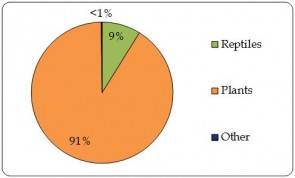
Figure 4.1.a Proportion of live individual plants and animals directly exported by taxonomic group, as reported by exporters (the Region) (all sources) (n=46.8 million).
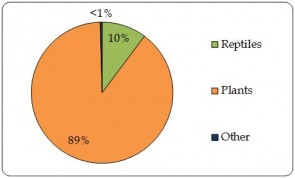
Figure 4.1.b. Proportion of live individual plants and animals directly exported by taxonomic group, as reported by importers (all sources) (n=37.1 million).
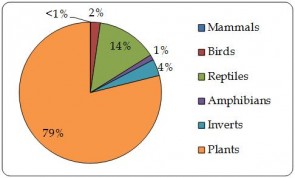
Figure 4.2.a. Proportion of live individual plants and animals directly exported by taxonomic group, as reported by exporters (the Region). “Wild-sourced” includes trade reported as sources ‘W’ and, ‘U’ and source unspecified (n=33,013).
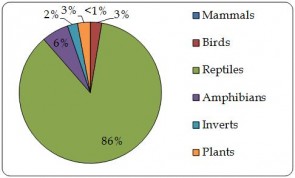
Figure 4.2.b. Proportion of live individual plants and animals directly exported by taxonomic group, as reported by importers. “Wild-sourced” includes trade reported as sources ‘W’ and ‘U’ (n=49,994).
Further investigation suggests that inconsistent source code reporting for two species, Iguana iguana and Cycas revoluta, explains the majority of the observed discrepancy between Figures 4.2.a and b. Further details on these species, which were also selected through the methodology described above, are provided as case studies below.
Iguana iguana (Green Iguana)
Trade in live, wild-sourced Iguana iguana is believed to be the main cause of the discrepancy highlighted in Figures 4.2.a and 4.2.b, with importers reporting levels of wild-sourced trade over 270 times the value of those reported by exporters (Figure 4.3). Exporter-reported quantities of live, captive-bred I. iguana were 11% higher than importer-reported quantities (Figure 4.4). Over the ten year period 2003-2012, 152 live, wild-sourced iguanas were reportedly exported by the Region according to exporter-reported data (all from Honduras), while importers reported the import of 41,341 live, wild-sourced iguanas from the Region (source ‘W’). Wild-sourced, live imports were reported by the United States, Turkey and the United Arab Emirates; the majority (>99%) were imported directly from El Salvador and the remainder from Honduras. El Salvador reported all direct exports of I. iguana to the aforementioned Parties to be captive-bred (source ‘C’). A permit analysis confirmed that in many cases, the same individuals in trade were reported differently. The same discrepancy is apparent in all years from 2003 onwards, with the exception of 2005-2006 and 2011-2012, when no wild-sourced imports were reported.
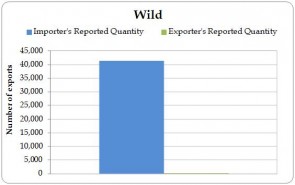
Figure 4.3. Wild-sourced direct exports of live Iguana iguana from the Region reported by exporters (the Region) and by importers, 2003-2012.
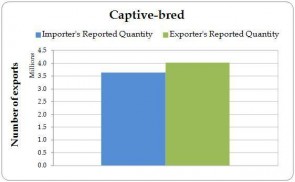
Figure 4.4. Captive-bred direct exports of live Iguana iguana from the Region reported by exporters (the Region) and by importers, 2003-2012.
Cycas revoluta
Although the majority of trade in Cycas revoluta from the Region was reported as artificially propagated (98%), Costa Rica reported the export of 22,000 wild-sourced live plants and 22,000 wild-sourced leaves (source ‘W’) in 2011. All trade reported by importers 2003-2012, with the exception of 295 plants reported as source ‘U’, was artificially propagated (Figure 4.5). The species does not naturally occur in the Region; it is native to China and Japan. Exporter-reported trade in artificially propagated live plants was also considerably higher than that reported by importers (Figure 4.6). A further 395,950 live plants (1.5%) were reported by the Region without a source specified.
Conclusions
The analysis identified 37 discrepancies where either the exporter or the importer reported trade levels of more than five times that of the trading partner. Of these, four species and one subspecies were reported as wild-sourced, whereas the remainder were either captive-bred or artificially propagated. The top ten cases of trade recorded by only one trading partner for wild-sourced and captive-bred/artificially propagated trade were also highlighted. Notable discrepancies in source code use were identified for two of the top species in trade from the Region: Iguana iguana and Cycas revoluta. Common reporting issues identified in this chapter include inconsistencies in the use of term codes, the use of non-preferred units and reporting at different taxonomic levels. Additionally, missing annual reports and incomplete reports (such as a lack of source or purpose information) were common explanations for a number of the discrepancies identified, highlighting potential key areas for improvement in reporting.
[1] See McGough in CITES at 40: Perspectives, trade patterns and future prospects. CITES CoP16 Inf. 35.
[2] For example CITES at 40: Perspectives, trade patterns and future prospects. CITES CoP16 Inf. 35.
